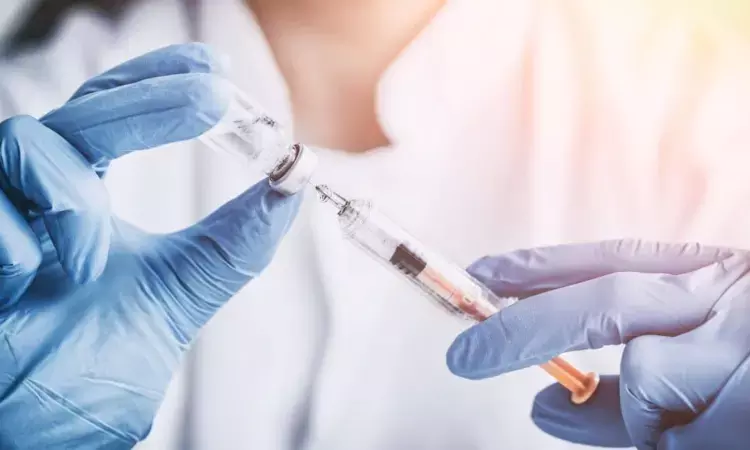- Home
- Medical news & Guidelines
- Anesthesiology
- Cardiology and CTVS
- Critical Care
- Dentistry
- Dermatology
- Diabetes and Endocrinology
- ENT
- Gastroenterology
- Medicine
- Nephrology
- Neurology
- Obstretics-Gynaecology
- Oncology
- Ophthalmology
- Orthopaedics
- Pediatrics-Neonatology
- Psychiatry
- Pulmonology
- Radiology
- Surgery
- Urology
- Laboratory Medicine
- Diet
- Nursing
- Paramedical
- Physiotherapy
- Health news
- Fact Check
- Bone Health Fact Check
- Brain Health Fact Check
- Cancer Related Fact Check
- Child Care Fact Check
- Dental and oral health fact check
- Diabetes and metabolic health fact check
- Diet and Nutrition Fact Check
- Eye and ENT Care Fact Check
- Fitness fact check
- Gut health fact check
- Heart health fact check
- Kidney health fact check
- Medical education fact check
- Men's health fact check
- Respiratory fact check
- Skin and hair care fact check
- Vaccine and Immunization fact check
- Women's health fact check
- AYUSH
- State News
- Andaman and Nicobar Islands
- Andhra Pradesh
- Arunachal Pradesh
- Assam
- Bihar
- Chandigarh
- Chattisgarh
- Dadra and Nagar Haveli
- Daman and Diu
- Delhi
- Goa
- Gujarat
- Haryana
- Himachal Pradesh
- Jammu & Kashmir
- Jharkhand
- Karnataka
- Kerala
- Ladakh
- Lakshadweep
- Madhya Pradesh
- Maharashtra
- Manipur
- Meghalaya
- Mizoram
- Nagaland
- Odisha
- Puducherry
- Punjab
- Rajasthan
- Sikkim
- Tamil Nadu
- Telangana
- Tripura
- Uttar Pradesh
- Uttrakhand
- West Bengal
- Medical Education
- Industry
Systemic and intralesional dupilumab successfully treated keloids and hypertrophic scars: Case study

USA: A recent case study published in the Journal of Drugs in Dermatology has suggested dermatologists consider treating extensive keloids with systemic dupilumab therapy, and intralesional delivery may be considered for more refractory keloids.
The case concerns a woman aged 44 years who developed hypertrophic scars and keloids following a severe herpes zoster infection. The administration of intralesional corticosteroid injections was not feasible owing to extensive scarring.
The patient was then initiated on systemic dupilumab therapy, which flattened and improved the texture of many scars. The largest keloid demonstrated significant improvement with intralesional dupilumab injections every two weeks, remarkable results were noted in 2 months.
Each year millions of people get negatively impacted by keloids and hypertrophic scars. In addition to cosmesis, symptomatic complaints (pruritus and pain) and functional impact contribute to poor quality of life. The mainstay of therapy is intralesional corticosteroid injections, however, several other treatment strategies (i.e. bleomycin, 5-fluorouracil, cryotherapy, laser therapy, scar revision) are utilised. Unfortunately, they all have limited efficacy with high rates of recurrence.
Lately, a better understanding of the immune dysregulation of various dermatologic conditions has led to the emergence of multiple cytokine-targeted therapies for several conditions. Various studies have implicated immune dysregulation of T helper 2 (Th2) in developing keloids and scars with interleukins (IL)-4 and -13 identified as pro-fibrotic mediators. Dupilumab is an IL-4 receptor alpha antagonist that inhibits the expression of both IL-4 and -13.
Michelle S. Min, Department of Dermatology, Brigham and Women’s Hospital, Harvard Medical School, Boston, MA, and colleagues described a 44-year-old woman who developed numerous disfiguring hypertrophic scars and keloids after suffering from a severe herpes zoster infection. Intralesional corticosteroid injections were not feasible given the number of scars. Therefore, systemic dupilumab treatment was initiated. Dupilumab 600 mg followed by 300 mg subcutaneous injections every two weeks was initiated.
Many scars flattened, and several even developed a cigarette-paper-like texture due to rapid involution. The largest and most recalcitrant keloid was treated further with intralesional dupliumab injections every two weeks, and an even more dramatic improvement was noted in 2 months.
"To our knowledge, this is the first report of treating hypertrophic scars and multiple keloids with both systemic and intralesional dupilumab," the researchers wrote.
"Dermatologists may want to consider keloid treatment that covers a large area with systemic dupilumab, a therapy with an established, reassuring safety profile," they concluded. "The most recalcitrant areas may benefit further from concentrating dupilumab by intralesional delivery."
Reference:
Min MS, Mazori DR, Lee MS, Merola JF, Vleugels RA, Cobos G, LaChance AH. Successful Treatment of Keloids and Hypertrophic Scars With Systemic and Intralesional Dupilumab. J Drugs Dermatol. 2023 Dec 1;22(12):1220-1222. doi: 10.36849/JDD.6385. PMID: 38051859.
Dr Kamal Kant Kohli-MBBS, DTCD- a chest specialist with more than 30 years of practice and a flair for writing clinical articles, Dr Kamal Kant Kohli joined Medical Dialogues as a Chief Editor of Medical News. Besides writing articles, as an editor, he proofreads and verifies all the medical content published on Medical Dialogues including those coming from journals, studies,medical conferences,guidelines etc. Email: drkohli@medicaldialogues.in. Contact no. 011-43720751


